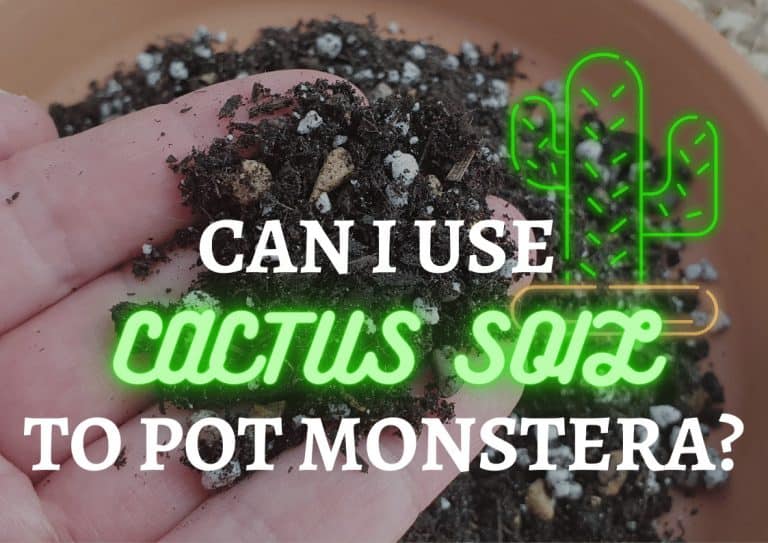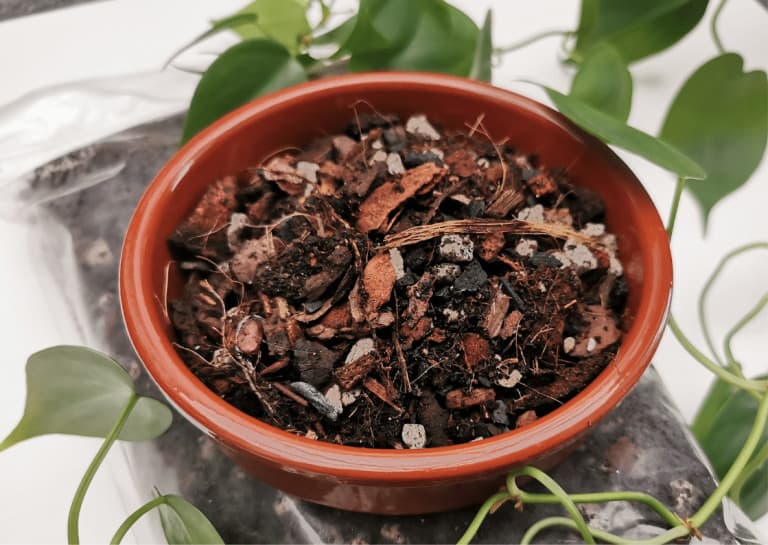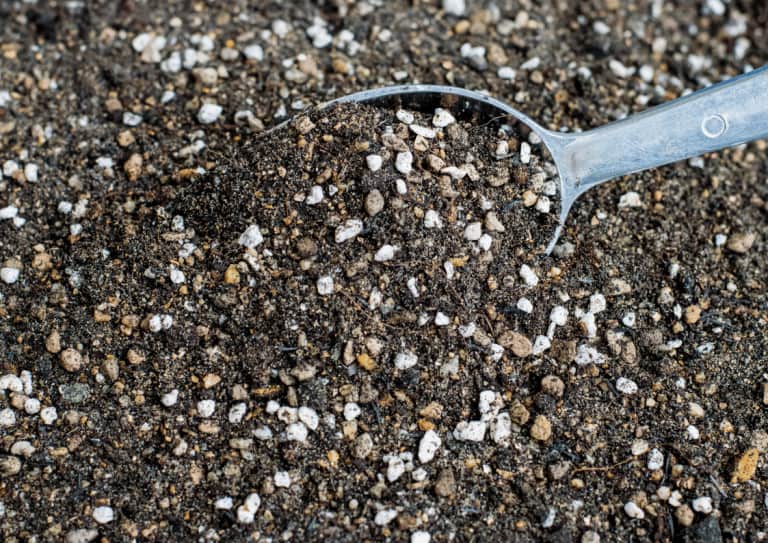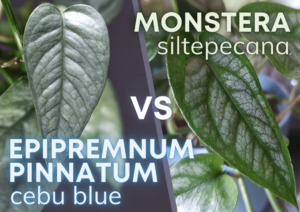Can I Use Cactus Soil To Pot My Monstera?
-
Chris Dosser
- December 27, 2021
If you buy something using the retail links in our articles, sometimes we earn a small affiliate commission. This does not impact the products we recommend.
Though Monstera species can be diverse in size, shape, and color, one thing remains constant across the genus: their need for a nutrient rich, free draining yet moisture retaining growing medium.
Choosing a suitable potting soil for your Monstera will make all the difference between your plant simply surviving versus actually thriving, so it’s worth learning the basics to help your plant grow beautifully. Many types of houseplant soil sold off the shelf will be completely unsuitable for meeting the needs of your Monstera.
Cacti soil for instance is normally a porous, quick-draining, low-fertility mixture and so will not be suitable for use in your Monstera pots without adding copious quantities of materials such as coco husk to aid with water retention and worm castings to provide a source of nutrition.
This post will cover all the basics of Monstera soil, what will happen to you if you use cactus soil, and what you can do to improve your cactus soil to ensure your Monstera will not only survive but beautifully thrive.
If you have your soil needs all sorted, yet your Monstera still doesn’t seem happy, the causes and remedies of drooping leaves are explored here.

The soil needs of Monstera plants is different to Cacti
Most store-bought potting soils aren’t going to meet the specific needs of your Monstera plant without a bit of help. So it’s best not to buy any old soil off the shelf and pray for the best.
Getting to know the specific soil needs of your Monstera can make the task of repotting your plant a bit easier.
As a TLDR summary, Monstera plants need their potting soils to have:
- organic matter that will retain water
- drainage that prevents roots from being constantly wet
- aeration to allow the roots to breath
- nutrients
- a pH of between 5.5 – 5.7
This is very different to Cacti soil which one leading compost manufacturer describes as “fast draining and nutrient poor”.
Water retention and drainage
One of the easiest ways to cause damage to your Monstera is to allow it to sit in water. Overwatering is the root cause of this issue, but soil that cannot correctly drain can also be to blame.
You will want to ensure that the soil you choose for your Monstera plant has aerating ingredients, such as pumice, mixed with water-absorbing materials, such as bark, compost, or coco coir.

Aeration
The perfect soil for your Monstera plant should be able to maintain aeration (the process of air circulation) without too much upkeep and input from you.
The soil you choose should be light and not easily compacted, which will allow for the roots of your Monstera to properly grow without cramping from the hard-packed ground.
Ingredients, such as bark, perlite or pumice, are essential components to a well-aerated potting soil.
Nutrition
The soil for your Monstera needs to have the proper nutrient balance to promote your plant’s growth and optimum health. Nutrient-boosting ingredients such as compost, biochar, and worm castings can up the nutritional value of your plant’s soil.
You should note that your Monstera plant will likely deplete the nutrients found within its soil in a few months. Potted Monstera plants do not have the nutrients provided by continually broken-down organic matter such as those in nature.
You will therefore need to regularly replenish your Monstera’s soil nutrients with a solid fertilizer.
Our Favorite Monstera Plants And Supplies On Etsy
Soil pH
Remember high school chemistry? pH is the measurement of how acidic or alkaline (basic) a substance is, and it’s a vital component to the ability of your Monstera plant to thrive.
Neutral pH is found at 7.0. Any number below that mark is considered acidic, and any number above is considered alkaline (basic). The pH of your plant’s soil is determined by what the soil consists of and the amount of water received.
The pH of your soil will take an active role in the growth of your Monstera, nutrient uptake, and soil bacteria balance.
Monstera plants thrive in a slightly acidic soil (pH 5.5 to 7) and so composts marked as ericaceous should be avoided (usually they have a pH of between 4 to 5).

What kinds of potting soils are harmful to Monstera plants?
Providing the best soil for your Monstera plant will make a world of difference in the viability of your plant. Let’s cover a few different types of commercial potting soil and what you can do to make more appropriate for your Monstera.
Cactus potting soil
Soil designed for cacti contains a high proportion of aggregate (sand, gravel, grit) and is extremely fast draining. Perfect for drought-resistant succulents and cacti.
It can however be too fast draining for your Monstera and leave your plant lacking much-needed water.
You could add large quantities of peat moss or coconut coir to your cactus soil to improve its water retaining capabilities however it will still be short of nutrients essential to Monstera.
For this fix, worm castings are a great organic fertiliser that is from a sustainable source and breaks down slowly.
Standard potting soil
It is not recommended that you use standard potting soil for your Monstera. It is typically far too dense and retains too much moisture to properly sustain your plant.
You can add a bit of perlite or other aerating ingredients to aid water drainage however this won’t automatically create an optimal growth medium for your Monstera.
Loamy potting soil
Loamy potting soil is soil consisting of silt, clay, and sand. It is exceptionally dense and retains a high level of water.
While this soil is suitable for many plants, it will not sustain your Monstera plant properly. You can add aeration ingredients, but it still may be too dense and compacted to act as the best growing medium for your Monstera.
Final thoughts
Being aware of the specific soil needs of your Monstera plant will make all the difference in your plant simply surviving and beautifully thriving.
When planting up or repotting a Monstera it’s best to avoid using soils originally intended for cacti as they lack the nutrients and water retaining qualities essential for the plant to grow uninhibited.
If you are in a pinch, you could add extra materials (such as coconut husk and worm castings) to your spare cactus potting soil. However you’ll need a large quantity of each to enrich the cactus compost to a point where it will be suitable for use.

Chris Dosser
Co-Founder of Eden Indoors
Chris is a self-taught horticulturist with over a decade of experience caring for houseplants and creating lush, thriving indoor oases. He specializes in Monstera, and by self admission has a serious problem with buying and propagating rare indoor plants!
Similar Posts
Why Are The Leaves Falling Off My Monstera Plant? (Incl. Fixes)
Are the leaves on your Monstera plant looking a bit droopy? Chances are it's nothing serious but to get your plant back to full health you need to act now!
Monstera Siltepecana vs Epipremnum Pinnatum Cebu Blue: Key Differences Explained
Are you struggling to tell the difference between Monstera Siltepecana and Epipremnum Pinnatum Cebu Blue? This article will help you identify and care for these two popular houseplants.



